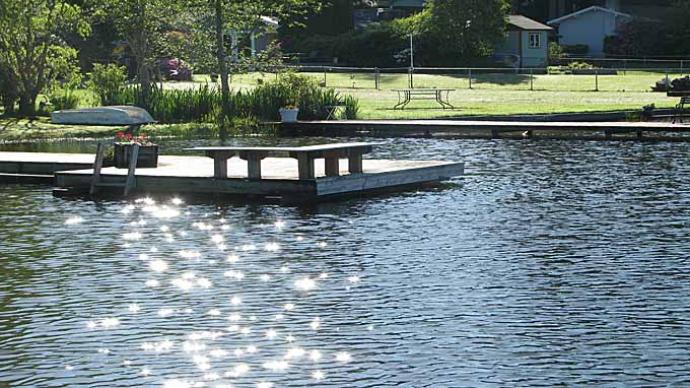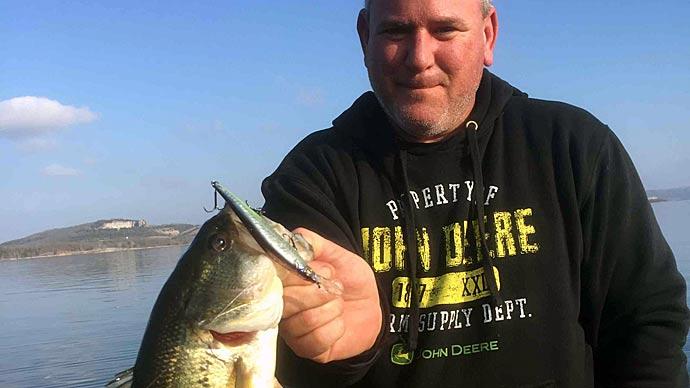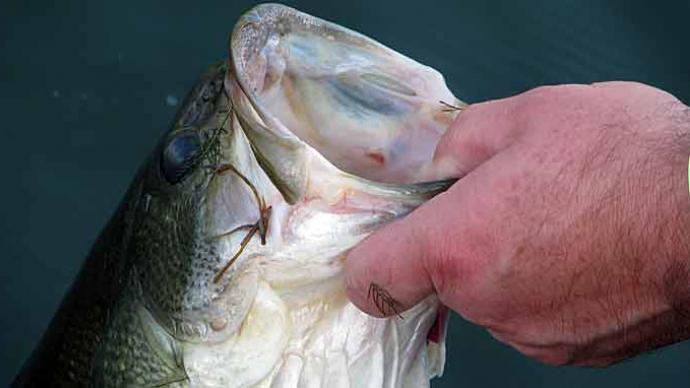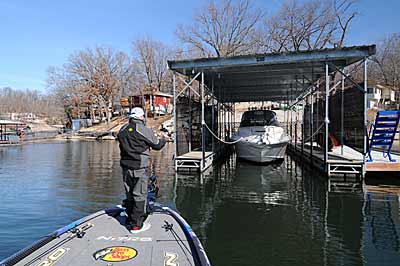
Docks offer all the comforts of home for bass throughout the winter.
Food, warmth, and shelter are all available to bass spending their winters hanging out around docks.
FLW pro Casey Scanlon has plenty of opportunities to catch wintertime bass around boat docks on his home waters of Lake of the Ozarks, the Missouri impoundment loaded with thousands of boat houses spread throughout the lake. Scanlon suggests bass anglers can fish docks all year, but the dock fishing tends to be forgotten during the winter when anglers focus on structures such as points and channel bends.
“Docks have a lot of cover, and the fish can move shallow or deep on the docks,” Scanlon says. “The fish are lethargic then and don’t have to go very far (for cover or food). They can call a dock home, move shallow to deep, and suspend around the dock.”
Baitfish and bluegill hang around docks throughout the winter and provide a buffet line for bass. Baitfish and bass are also attracted to the warmth emanating from the dock’s floatation, which absorbs heat from the sun’s rays.
Scanlon suggests the best docks for winter bass fishing have some cover, such as sunken brush piles near the boat houses. The Missouri pro also favors docks with cables where bass suspend next to those cables.
On a lake with multiple docks, such as Lake of the Ozarks, Scanlon checks out the bottom contour to determine the most productive wintertime docks. “You want a dock situated around deep water,” Scanlon says. He notes shallow docks are more productive in the spring when the water warms, but in the winter, bass seek docks along deep water structure such as steep chunk rock banks or channel banks.
The best docks can either be on the main lake or in the coves because bass will spend their winters along creek channels in the larger coves or river channels on the main arms of the lake. “You just have to pinpoint where the fish are and follow the channels as the main goal,” Scanlon says. He prefers fishing isolated docks on structure rather than a row of multiple docks because bass congregate better on a single dock but scatter along a row of docks.
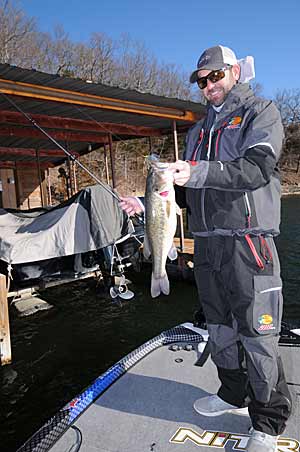
The critical areas of docks to fish during wintertime depend on the depth over which the floating structure sits. If he is fishing a dock sitting over depths of 30 feet or more, Scanlon will fish more toward the back ends of the dock. The Lake of the Ozarks guide will key on the front and sides of docks sitting in 30 feet or less and try the backs of docks during a spell of warm winter weather.
“I usually come from the side and make a few pitches towards the back and then work around the front of the dock,” Scanlon says of his dock presentations. He will also throw into boat wells—especially on sunny days—because many docks have brush piles planted in the wells. He also likes to skip lures under the docks through the cracks of the floatation for fish hiding under the decks.
Scanlon considers calm skies and sunshine the ideal weather for winter dock fishing when bass suspend in the water column and are susceptible to suspending jerkbaits, swimbaits, and Alabama rigs. He also catches bottom-hugging bass with jigs worked around docks on cloudy days.
The 2013 Bassmaster Classic qualifier opts for either a 1/2- or 5/8-ounce jig for fishing deep along the docks or a 5/16- or 7/16-ounce Finesse Jig for fishing shallow with a slow fall along the back ends of docks. He tips the jigs with a craw, Zoom Critter Craw, twin-tail plastic grub, or a plastic chunk. His favorite jig colors are green pumpkin and black and blue.
“Typically, I will use a little bit lighter weight jig than I would in the warmer months and just force myself to fish that thing slowly and just crawl it along the bottom,” Scanlon says. When he feels the jig bump into brush or rocks, he will lift the lure and hop it over the cover to trigger reaction strikes.
Scanlon tempts the fish with a Tackle HD jerkbait in shad patterns when he notices bass suspended along the docks. He favors jerkbaits in translucent colors on sunny days and clear water but switches to louder colors such as chartreuse hues or a clown pattern for stained fishing water or cloudy weather.
A jerkbait with neutral buoyancy or slowly sinking works best for Scanlon’s dock fishing tactics. He employs a slow retrieve with two or three twitches of his rod followed by a pause of varying lengths. “Some days the fish seem to want it faster, and other days they want it dead-sticked,” Scanlon says.
A single 3.5- or 4-inch Tackle HD Swimmer swimbait rigged on a 1/4-ounce jighead or multiple swimbaits attached to an Alabama rig also produce wintertime bass for Scanlon when he targets docks. His favorite swimbait colors are pearl or grey ghost for cloudy days, alewife and other translucent colors for sunny calm days, and gin clear water.
The touring pro scans the dock with his Garmin Panoptix Livescope to determine the depth of the suspending bass and then casts his swimbait or Alabama rig to the fish. He lets the lure sink to the depth of the fish and then employs a slow, steady retrieve, usually in the 8- to 10-foot depth range.
The winter dock pattern continues to produce for Scanlon until the spawn when bass eventually move to the flatter banks to build their nests.


